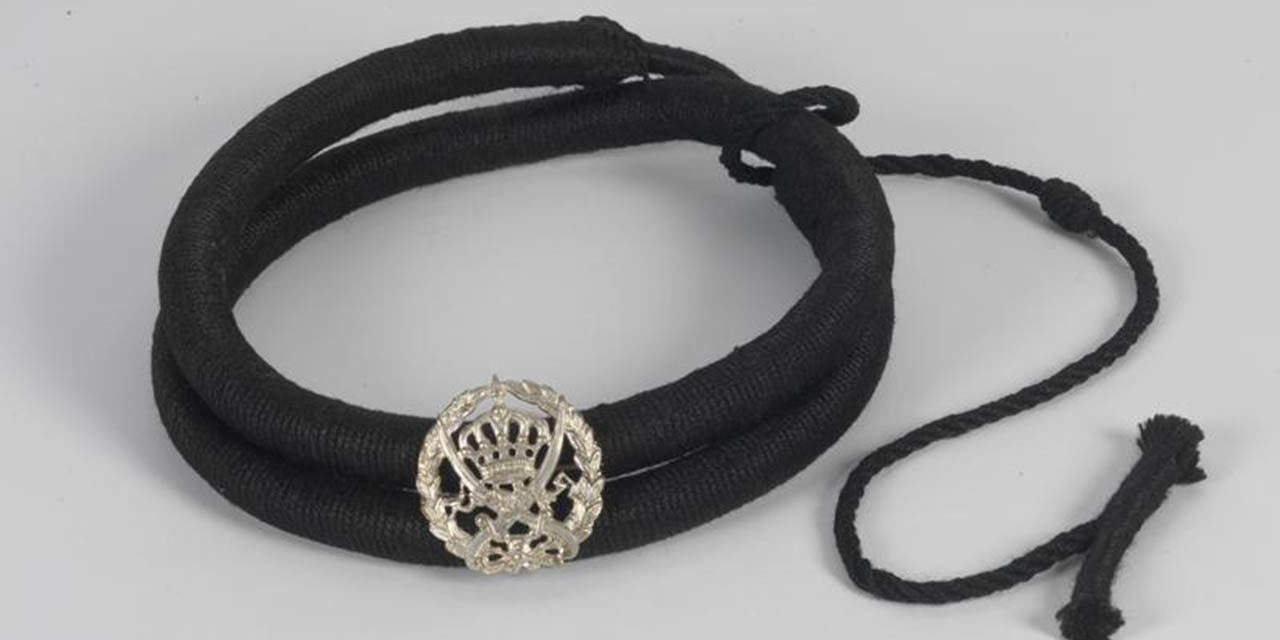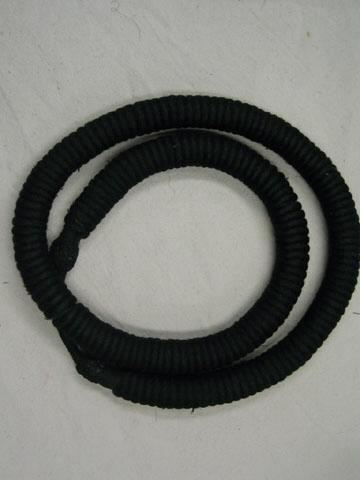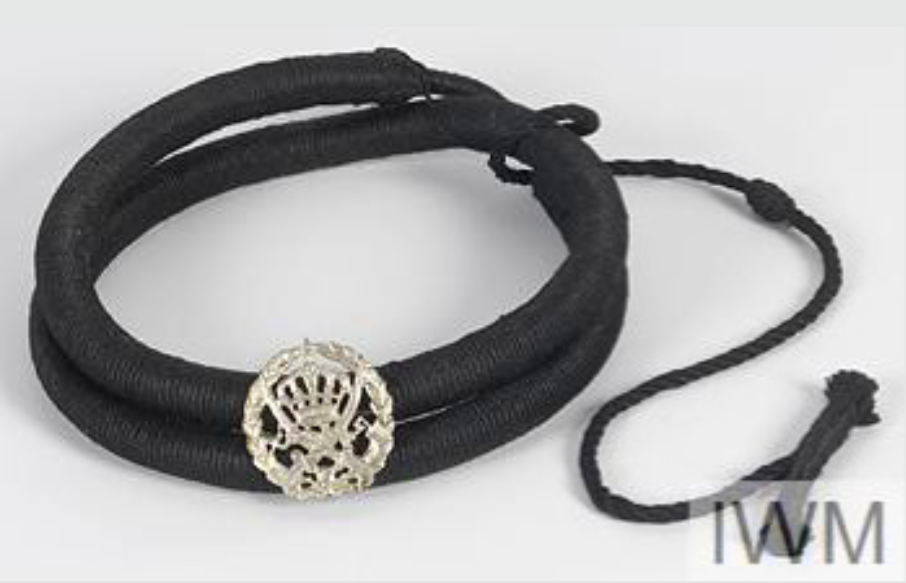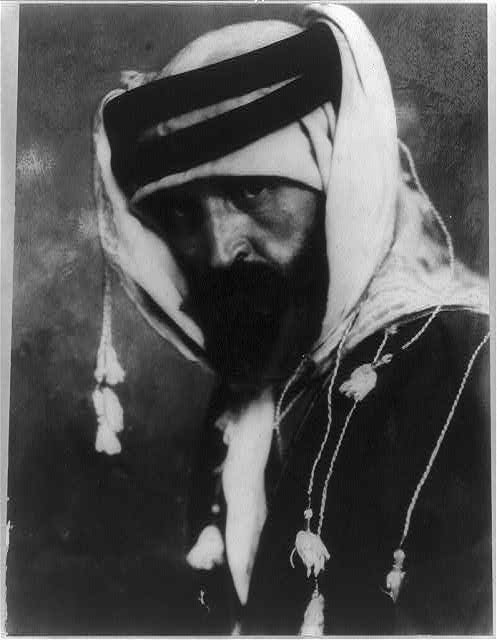An agal is a rope made from animal hair which wraps around a keffiya (square cloth) on the head and is worn typically by Bedouin men.
The Details
Betty Wass El-Wakil describes twentieth-century Egyptian dress and the agal in the Berg Encyclopedia of World Dress and Fashion (2010):
“The headgear is the distinctive dress of the Bedouin man. A kefiyya (square cloth) is folded into a triangle and anchored on the head with ’aqal (decorative ropes). The kefiyya covers the head and neck, providing protection from the hot sun and blowing sand, and can be wrapped around to shelter the face if needed.” (186)
A black wool agal (Fig. 1), dating to 1949, is displayed at Rhode Island School of Design Museum, showing the texture of the coils.
In “Arab Men’s Dress in the Eastern Mediterranean” in the Berg Encyclopedia of World Dress and Fashion: Central and Southwest Asia, Widad Kawar and Sibba Einarsdóttir explain the history of the aqal:
“aqal were relatively thick and later became thinner. They were made of black goat hair, brown camel hair, or brown sheep wool. High-status Bedouin wore special head ropes (aqal maqasab) of wool or camel hair bound at intervals with gold thread.” (170–172).
Figure 2 displays a traditional agal worn over a keffiyeh, which is often seen today worn by men in many Arab countries.
Kawar and Einarsdóttir continue, explaining:
“Arab men normally cover their heads as a sign of respect for others. Unlike in the Western world, headgear is not taken off when entering a house or even when entering a mosque, because the head must be covered while saying prayers. Until the latter half of the twentieth century, not to wear something on the head when in public was regarded as being socially very low and uncouth (The ‘aqal, or head rope, is taken off in religious place).” (170–172)
The Imperial War Museum has a traditional coiled black cloth rope agal with a metal badge from the Arab Legion (Fig. 3) in its collection.
In the Berg Encyclopedia of World Dress and Fashion (2010) article on “Iraqi Dress,” authors Ulrike Al-Khamis and Saad Lafta Hami explain:
“The keffiyeh was generally secured with one of a variety of ‘aqals or head ropes. These could consist of thick strings of black wool bound at regular intervals into tubular units or, for sheikhs, fine black wool or silk tightly bound with gold thread to form stiff bars. Gradually, these elaborate ropes were replaced by twice-wound heavy black or dark brown cords of varying thickness, made of wool or camel hair and imported from Syria.” (262–274).
Unlike traditional agals made of wool, the British Museum holds an agal (Fig. 4) made of cotton, silk, and gold, dating to 1974, likely made for a sheikh as Al-Khamis and Hami describe.
In a Babylonian bust from the Met (Fig. 5) dating to the late 8th or early 7th century BCE, the ficure is depicted wearing an agal, which demonstrates how long agal have been a part of dress in the region.
The authors further explain:
“As elsewhere in Iraq, male headgear in general is the most important marker of social and religious distinctions. Whereas wearing the ‘aqal over the head cloth indicates tribal identity in the larger confederations of the south, people not wearing the ‘aqal and wearing the headscarf folded back over the head in a semi turban style are identified as coastal or palm-cultivating Arabs from the Shatt al-‘Arab region.” (Al-Khamis Lafta-Hami 262–274)
An image from the Library of Congress (Fig. 6) depicts an Arab man, photographed sometime between 1890 and 1923. He is seen wearing a thick agal over a white head covering.
In the History of World Costume and Fashion (2011), Daniel Delis Hill explains:
“To secure the ghutra in place, a double circlet called an agal (also igal or igaal) made of black goat’s hair is fitted about the crown. The word agal is similar to the term for a nomad’s tethering rope, which may have been the original source of the head piece.” (171).
Agal are a long-standing part of Arab men’s dress which have been seen historically in many forms and continue to be worn today.
Fig. 1 - Artist unknown (Arabian). Agal, 1949. Wool. Rhode Island: Rhode Island School of Design Museum, 69.138E. Gift of the Estate of Theodore Francis Green. Source: RISD Museum
Fig. 2 - Maker unknown (Syria or Jordan). Keffiyeh and agal, Date unknown. Riga, Latvia: The World of Hat Museum. Source: The World of Hat
Fig. 3 - Maker unknown. Agal (with badge): Arab Legion, 1945-1989 (association. Whole: cloth. Imperial War Museum (IWM), UNI 12240. Source: IWM
Fig. 4 - Maker unknown (Middle East: Arabia: Saudi Arabia). Head-Rope, 1974. Cotton, silk, gold; 119 centimetres cm. London: The British Museum, As1974,05.3. Gerald de Gaury. Source: The British Museum
Fig. 5 - Artist unknown (Babylonian). Head, ca. late 8th–early 7th century B.C.. Ceramic. New York: Metropolitan Museum of Art, 1979.398. Fletcher, Dodge, Louis V. Bell and Harris Brisbane Dick Funds, 1979. Source: Met
Fig. 6 - Photographer unknown. Arab, between 1890 and 1923. Washington: Library of Congress, 1979.398. Frank and Frances Carpenter Collection. Source: LOC
References:
- Al-Khamis, Ulrike, and Saad Lafta Hami. “Iraqi Dress.” In Berg Encyclopedia of World Dress and Fashion: Central and Southwest Asia, edited by Gillian Vogelsang-Eastwood, 262–274. Oxford: Berg Publishers, 2010. http://dx.doi.org.libproxy.fitsuny.edu/10.2752/BEWDF/EDch5046.
- El-Wakil, Betty Wass. “Dress in Egypt in the Twentieth Century.” In Berg Encyclopedia of World Dress and Fashion: Africa, edited by Joanne B. Eicher and Doran H. Ross, 180–186. Oxford: Berg Publishers, 2010. http://dx.doi.org.libproxy.fitsuny.edu/10.2752/BEWDF/EDch1026.
- Hill, Daniel Delis. “The Islamic Empire.” In History of World Costume and Fashion, 161–84. Upper Saddle River, NJ: Prentice Hall, 2011. http://www.worldcat.org/oclc/768100950
- Kawar, Widad, and Sibba Einarsdóttir. “Arab Men’s Dress in the Eastern Mediterranean.” In Berg Encyclopedia of World Dress and Fashion: Central and Southwest Asia, edited by Gillian Vogelsang-Eastwood, 170–172. Oxford: Berg Publishers, 2010. http://dx.doi.org.libproxy.fitsuny.edu/10.2752/BEWDF/EDch5029.
















